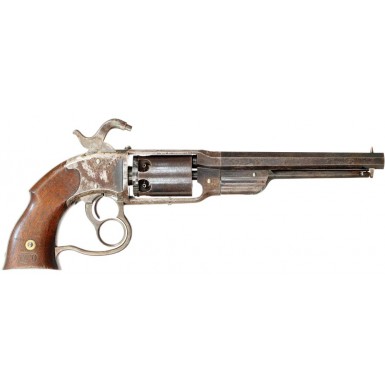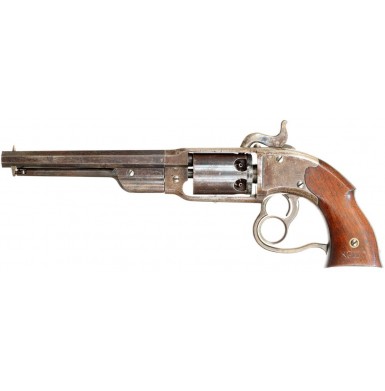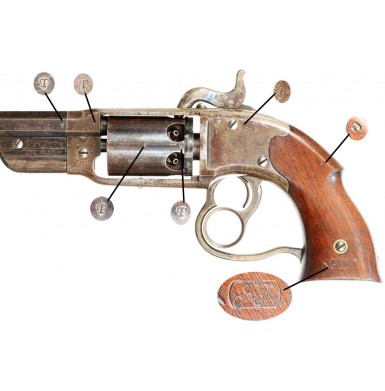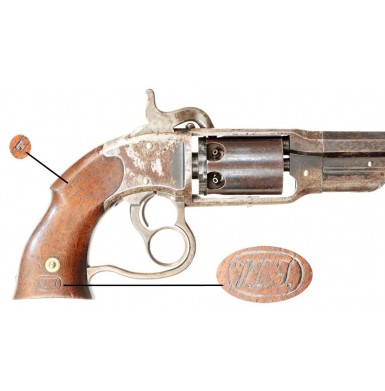The Savage “Navy” self-cocking revolver is one of the weirdest, and possibly most ungainly handguns of the Civil War era, but also has one of the most recognizable profiles. The .36 caliber, 6-shot revolver had a 7” octagonal barrel and an innovative ring-cocking action and a moving gas seal cylinder. The gun featured a unique ring shaped cocking lever inside the heart shaped trigger guard, which was used to advance the cylinder and cock the hammer. The shooter could then fire the gun with the traditional trigger. The design was similar to the lock work employed in William Tranter’s “double trigger” revolvers. The gun was the final version of a family of self-cocking revolvers that were built upon the “Figure-8” design of JS North. Beyond its unique action, the gun was revolutionary in that was a “gas seal” revolver. The cylinder moved forward when the action cocked, and a recess in the chamber mouth engaged the tapered forcing cone at the rear of the barrel. The effect was a gas seal between the chamber and the barrel, which practically eliminated the loss of gas and pressure from the usual gap between the barrel and cylinder. This meant that the gas created from the ignition of the powder charge was more effectively converted into propulsion for the bullet. This increased the velocity of the bullet for a given powder charge over convectional revolver designs, which allowed much of the propulsive force to escape in the space between the cylinder and the barrel. This innovative design would not be revisited again on a widespread basis for a military revolver until the adoption of the M-1895 Nagant revolver by the Russian military. From the very beginning, the revolver had been intended as a martial arm by its inventors and manufacturers, and significant effort was put forth in the years preceding the war to obtain a US military contract for the innovative, if somewhat cumbersome revolvers. With the coming of the Civil War, the need for revolvers outweighed any misgivings that the military may have had about the design, and the coveted contracts were almost immediately forthcoming. The state of Massachusetts procured 285 of the Savage revolvers early in the conflict. Additional arms were sold to military outfitters and New York based arms retailers like Schuyler, Hartley & Graham and William Syms & Brothers. Both of these companies sold Savage Navy revolvers to the US government during early 1862, for as much as $25 per gun. The Savage Revolving Firearms Company secured its first official US military contract directly with the US government on October 16, 1861. This contract called for Savage to deliver 5,000 pistols between October 1861 and March 1862 at the price of $20 per revolver. Another contract was received from the government in November of 1861 to supply an additional 5,000 revolvers, at $20 each, between November 1861 and May of 1862. Savage completed their initial contract in a timely fashion, but had trouble delivering the guns for the second contract on the agreed to schedule. The second contract was temporarily voided by the Ordnance Department, but after negotiating with Savage, an agreement was reached where the 4,500 outstanding guns from that contract would be delivered at the lower rate of $19.00 per pistol. The deliveries under the second contract were completed by July of 1862. Of the approximately 20,000 Savage “Navy” models produced during the Civil War, the US Ordnance Department took delivery of 11,384 of the guns, and the Navy took delivery of 1,126. The balance of approximately 8,500 guns were offered for civilian sale, although most of those revolvers no doubt ended up seeing action during the war as well. The pistols saw significant field service during the war, and were issued to at least twenty-six different US cavalry regiments and were listed among the arms of some half dozen or more Confederate cavalry regiments. US volunteer cavalry regiments that were issued Savage Navy revolvers included the 6th, 10th & 13th Illinois, the 5th & 15th Kansas, 11th Kentucky, the 3rd, 4th & 7th Missouri, 7th New York 3rd Ohio, 7th Pennsylvania, 1st & 2nd Wisconsin, 1st Vermont and the Potomac Brigade. The revolvers were also issued to the 1st through 9th Missouri State Militia Cavalry. The two regiments who carried the most Savages on their ordnance rolls were the 4th Missouri State Militia Cavalry with 714 and the 2nd Wisconsin with 400. Confederate cavalry units that listed the Savage Navy among their arms were the 11th Texas, 7th Virginia, and the 34th & 35th Virginia Cavalry Battalions. After the war, the Ordnance Department disposed of the Savage Navy revolvers rather quickly. They sold some 773 during 1866 at prices varying from $1.50 to $3.45 each. During 1875, they sold an additional 3,951 of the revolvers for prices as low as $0.35 to as high as $0.58 each; a far cry from the $19 to $25 each they paid during the war years.
This example of the Savage Revolving Firearms Company “Navy” Revolver is in FINE condition overall. It is an extremely crisp, martially marked example that is 100% complete and correct in every way and retains a significant amount of finish. Savage Navy revolvers have a reputation for being difficult to find with any amount of original finish, or with grips that are not in relatively rough shape. This gun retains a significant amount of original blue on its barrel and cylinder (probably 30%-40% on both parts) and has an outstanding set of original, martially inspected grips that are correctly numbered to the gun. These .36 caliber, six shot revolvers also had a reputation for being very temperamental mechanically during the period of use, and finding one that is in perfect mechanical working order today is quite difficult. This pistol is mechanically excellent and functions exactly as it should in every way. As is typical of Savage Navy revolvers, the gun is serial numbered on the frame, under the grips. The later production Savage Navy revolvers are typically found with an assembly number as well, while earlier production guns did not include an assembly number and used the serial number on the major components. In this case, the serial number on the rearward portion of the right grip frame, under the right grip is 1278. The matching serial number 1278 is present on the bottom of the barrel (this requires the removal of the cylinder arbor pin and loading mechanism to see), and is also lightly penciled on the interior of the left grip panel. The rear of the cylinder and the ratchet plate are both unnumbered, but are clearly original to the revolver and match its overall appearance and patina perfectly. The rear of the cylinder is marked with a small inspection letter S. The top strap of the revolver is clearly marked in three lines: SAVAGE R.F.A. Co. MIDDLETOWN, CT / H.S. NORTH PATENTED JUNE 17 1856 / JANUARY 10 1859. MAY 15 1860. The markings are often light on these revolvers, so it is nice to see one where they are deep, crisp and very clear. As has already been mentioned, the action of the revolver works perfectly, with a long, heavy pull of the ring beneath the trigger indexing the cylinder to the rear, rotating it and then locking it into the forward position and cocking the hammer. A single pull of this lever prepares the six shot, .36-caliber (hence the name “Navy”) revolver, to fire. Pulling the trigger releases the hammer as it should. The gun retains about 30%+ thinning blue on the octagon barrel, and a similar amount on the web beneath the barrel that contains ramming portion of the loading lever. Most of the barrel blue in on the bottom flat where it has been protected by the loading lever, but strong streaks of original bright blue remain visible on the balance of the barrel. The frame of the revolver retains some traces of blue, primarily in the protected areas were the rear of the frame and the recoil shield meet, with some flecks of blue on the gripstrap around the trigger. The cylinder retains 30%+ thinning blue as well. The case-hardened hammer retains about 50%+ dulling, mottled colors, and the triggerguard and ring lever retain some strong traces of the case coloring, which has dulled and mixed with a smoky gray patina, with hints oxidized brown discoloration. The balance of the frame, cylinder and barrel where the bluing has worn or faded, has a mostly smooth plumb brown patina with the topstrap showing a mottled brownish-gray patina. There are some scattered areas of thin brown surface oxidation present on the metal and shot through the thinning, streaky blue. The metal of the frame and barrel is mostly smooth and with only some lightly scattered areas of pinpricking and peppering and a few flecks of minor pitting. However, the cylinder does shows some more moderately scattered surface oxidation. There is some pinpricking and very minor erosion around the recessed cone seats of the cylinder and on the inside of the top strap and around the hole through which the centrally slung hammer engages the percussion caps. Savage Navy revolvers are notorious for having heavily battered and damaged cones, probably because of the way the hammer strikes them and because there is potential for the hammer to drag on the cone if the operating lever is not pulled briskly. As such, broken and shattered cones are a common condition issue with these revolvers. This gun is the exception and all the cones (nipples) are all in extremely crisp and completely usable condition. The gun retains the original tall brass cone shaped front sight, which is still full height and remains quite crisp. This is nice as the sight is typically worn down to a bead or missing completely. The brass cone is thicker on the early production revolvers than on the guns produced later in the contract series, and this gun shows the thick sight as it should. All the edges of the metal are still very sharp and crisp and the bore is in about FINE overall condition as well. It is mostly bright, with extremely crisp, showing only some minor debris and accumulated gunk along its length. The original loading lever is in place under the barrel and remains fully functional, operating smoothly as it should. The lever and its retaining catch both function perfectly and the lever locks securely into place when not in use. The gun is marked profusely with the US military sub-inspector mark T throughout. This letter appears repeatedly on the frame, cylinder, barrel and even on the upper rear portion of each of the two grip panels. This is the mark of armory sub-inspector John Tayler who spent most of his Civil War service inspecting arms in the Hartford, CT area, including Henry Rifles and Colt revolvers and muskets. The two-piece grips rate about VERY FINE overall and are some of the best original Savage Navy grips that I have ever seen. They show only the most minor wear and handling marks and are free of any breaks, cracks or repairs. The thin panels are often severely cracked, damaged, repaired or even replaced. These grips are simply in fantastic condition and have a wonderful set of cartouches on each panel. The script cartouche on the right panel is the JT, the mark of US armory sub-inspector John Taylor. The right grip has the large script cartouche WAT in an oval, the mark of Brevet Brigadier General William Anderson Thornton. Thornton would spend more time as the chief inspector of contract arms than any other US Ordnance Department officer during the 19th century, and his mark is found on contract small arms that cover more than two decades of deliveries, from the end of the US M-1816 musket contracts circa 1840 through the middle of the Civil War, when his promotion placed him in overall charge of contract arms inspection. As a result, he delegated the actual inspection work to lower ranking ordnance officers, and after some time in 1863, he no longer applied his cartouche to anymore US military arms.
Overall this a really great example of a scarce and desirable, martially marked Savage Navy revolver, in fine condition; significantly better condition than the large majority of surviving examples. Finding a Savage Navy with any amount of original finish is very difficult, and finding a martially marked example that is this crisp, with such sharp and well-marked grips is a real rarity. Even though the gun remains in such very nice and crisp condition, it clearly saw at least some real-world use and is sort of the perfect balance between a minty gun that saw no action and a heavily used and abused gun that is now in rough shape. The pistol is mechanically excellent, is extremely well marked and displays wonderfully. This is a Savage Navy that is head and shoulders better than the ones that are seen for sale these days and it would take a lot of money and luck to find one that was crisper with more finish and such fine grips. This is a really great, no excuses, revolver that will be a wonderful addition to any Civil War handgun collection, that you will certainly be very proud to own and display.
SOLD







